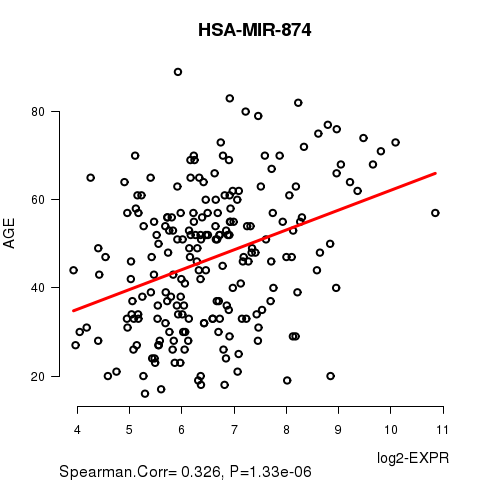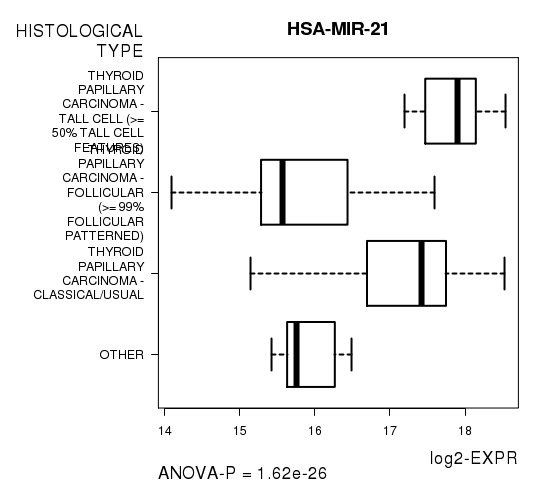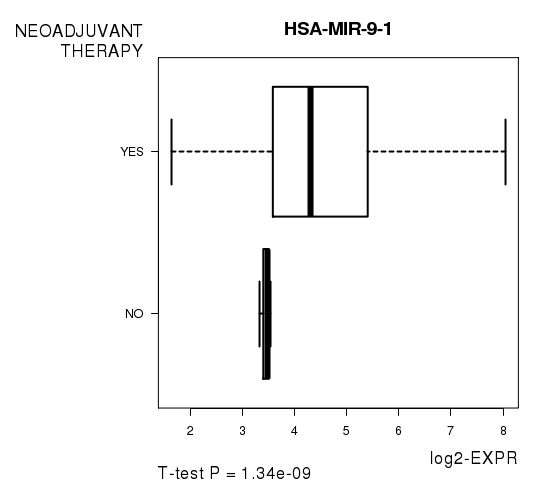This pipeline uses various statistical tests to identify miRs whose expression levels correlated to selected clinical features.
Testing the association between 531 genes and 5 clinical features across 210 samples, statistically thresholded by Q value < 0.05, 4 clinical features related to at least one genes.
-
5 genes correlated to 'AGE'.
-
HSA-MIR-874 , HSA-MIR-362 , HSA-MIR-500A , HSA-MIR-1229 , HSA-MIR-152
-
108 genes correlated to 'HISTOLOGICAL.TYPE'.
-
HSA-MIR-21 , HSA-MIR-146B , HSA-MIR-7-2 , HSA-MIR-31 , HSA-MIR-152 , ...
-
10 genes correlated to 'RADIATIONS.RADIATION.REGIMENINDICATION'.
-
HSA-MIR-1269 , HSA-MIR-888 , HSA-MIR-374A , HSA-MIR-3130-1 , HSA-MIR-324 , ...
-
3 genes correlated to 'NEOADJUVANT.THERAPY'.
-
HSA-MIR-9-1 , HSA-MIR-424 , HSA-MIR-129-1
-
No genes correlated to 'GENDER'
Complete statistical result table is provided in Supplement Table 1
Table 1. Get Full Table This table shows the clinical features, statistical methods used, and the number of genes that are significantly associated with each clinical feature at Q value < 0.05.
| Clinical feature | Statistical test | Significant genes | Associated with | Associated with | ||
|---|---|---|---|---|---|---|
| AGE | Spearman correlation test | N=5 | older | N=5 | younger | N=0 |
| GENDER | t test | N=0 | ||||
| HISTOLOGICAL TYPE | ANOVA test | N=108 | ||||
| RADIATIONS RADIATION REGIMENINDICATION | t test | N=10 | yes | N=8 | no | N=2 |
| NEOADJUVANT THERAPY | t test | N=3 | yes | N=2 | no | N=1 |
Table S1. Basic characteristics of clinical feature: 'AGE'
| AGE | Mean (SD) | 46.6 (16) |
| Significant markers | N = 5 | |
| pos. correlated | 5 | |
| neg. correlated | 0 |
Table S2. Get Full Table List of 5 genes significantly correlated to 'AGE' by Spearman correlation test
| SpearmanCorr | corrP | Q | |
|---|---|---|---|
| HSA-MIR-874 | 0.3264 | 1.332e-06 | 0.000707 |
| HSA-MIR-362 | 0.2904 | 1.904e-05 | 0.0101 |
| HSA-MIR-500A | 0.2869 | 2.418e-05 | 0.0128 |
| HSA-MIR-1229 | 0.2845 | 9.088e-05 | 0.048 |
| HSA-MIR-152 | 0.2663 | 9.361e-05 | 0.0493 |
Figure S1. Get High-res Image As an example, this figure shows the association of HSA-MIR-874 to 'AGE'. P value = 1.33e-06 with Spearman correlation analysis. The straight line presents the best linear regression.

Table S3. Basic characteristics of clinical feature: 'GENDER'
| GENDER | Labels | N |
| FEMALE | 155 | |
| MALE | 55 | |
| Significant markers | N = 0 |
Table S4. Basic characteristics of clinical feature: 'HISTOLOGICAL.TYPE'
| HISTOLOGICAL.TYPE | Labels | N |
| OTHER | 8 | |
| THYROID PAPILLARY CARCINOMA - CLASSICAL/USUAL | 116 | |
| THYROID PAPILLARY CARCINOMA - FOLLICULAR (>= 99% FOLLICULAR PATTERNED) | 64 | |
| THYROID PAPILLARY CARCINOMA - TALL CELL (>= 50% TALL CELL FEATURES) | 22 | |
| Significant markers | N = 108 |
Table S5. Get Full Table List of top 10 genes differentially expressed by 'HISTOLOGICAL.TYPE'
| ANOVA_P | Q | |
|---|---|---|
| HSA-MIR-21 | 1.615e-26 | 8.58e-24 |
| HSA-MIR-146B | 2.124e-17 | 1.13e-14 |
| HSA-MIR-7-2 | 7.643e-17 | 4.04e-14 |
| HSA-MIR-31 | 1.99e-15 | 1.05e-12 |
| HSA-MIR-152 | 3.367e-14 | 1.77e-11 |
| HSA-MIR-3926-1 | 4.425e-13 | 2.33e-10 |
| HSA-MIR-1179 | 1.688e-12 | 8.86e-10 |
| HSA-MIR-30C-2 | 3.353e-12 | 1.76e-09 |
| HSA-MIR-204 | 3.663e-12 | 1.92e-09 |
| HSA-MIR-511-1 | 4.908e-12 | 2.56e-09 |
Figure S2. Get High-res Image As an example, this figure shows the association of HSA-MIR-21 to 'HISTOLOGICAL.TYPE'. P value = 1.62e-26 with ANOVA analysis.

10 genes related to 'RADIATIONS.RADIATION.REGIMENINDICATION'.
Table S6. Basic characteristics of clinical feature: 'RADIATIONS.RADIATION.REGIMENINDICATION'
| RADIATIONS.RADIATION.REGIMENINDICATION | Labels | N |
| NO | 14 | |
| YES | 196 | |
| Significant markers | N = 10 | |
| Higher in YES | 8 | |
| Higher in NO | 2 |
Table S7. Get Full Table List of 10 genes differentially expressed by 'RADIATIONS.RADIATION.REGIMENINDICATION'
| T(pos if higher in 'YES') | ttestP | Q | AUC | |
|---|---|---|---|---|
| HSA-MIR-1269 | 6.86 | 1.228e-08 | 6.43e-06 | 0.8656 |
| HSA-MIR-888 | 6.37 | 6.913e-08 | 3.62e-05 | 0.8256 |
| HSA-MIR-374A | -7.22 | 5.909e-07 | 0.000308 | 0.8535 |
| HSA-MIR-3130-1 | -6.07 | 1.924e-06 | 0.001 | 0.7775 |
| HSA-MIR-324 | 6.38 | 2.643e-06 | 0.00137 | 0.8065 |
| HSA-MIR-2276 | 6.16 | 2.941e-06 | 0.00153 | 0.783 |
| HSA-MIR-1976 | 5.71 | 1.724e-05 | 0.00893 | 0.8105 |
| HSA-MIR-660 | 5.56 | 2.584e-05 | 0.0134 | 0.8156 |
| HSA-MIR-20B | 5.32 | 3.979e-05 | 0.0205 | 0.7912 |
| HSA-MIR-652 | 5.19 | 6.415e-05 | 0.033 | 0.8072 |
Figure S3. Get High-res Image As an example, this figure shows the association of HSA-MIR-1269 to 'RADIATIONS.RADIATION.REGIMENINDICATION'. P value = 1.23e-08 with T-test analysis.

Table S8. Basic characteristics of clinical feature: 'NEOADJUVANT.THERAPY'
| NEOADJUVANT.THERAPY | Labels | N |
| NO | 3 | |
| YES | 207 | |
| Significant markers | N = 3 | |
| Higher in YES | 2 | |
| Higher in NO | 1 |
Table S9. Get Full Table List of 3 genes differentially expressed by 'NEOADJUVANT.THERAPY'
| T(pos if higher in 'YES') | ttestP | Q | AUC | |
|---|---|---|---|---|
| HSA-MIR-9-1 | 9.53 | 1.337e-09 | 5.07e-07 | 0.7971 |
| HSA-MIR-424 | -10.13 | 1.489e-07 | 5.63e-05 | 0.8422 |
| HSA-MIR-129-1 | 13.84 | 2.342e-06 | 0.000883 | 0.9125 |
Figure S4. Get High-res Image As an example, this figure shows the association of HSA-MIR-9-1 to 'NEOADJUVANT.THERAPY'. P value = 1.34e-09 with T-test analysis.

-
Expresson data file = THCA.miRseq_RPKM_log2.txt
-
Clinical data file = THCA.clin.merged.picked.txt
-
Number of patients = 210
-
Number of genes = 531
-
Number of clinical features = 5
For continuous numerical clinical features, Spearman's rank correlation coefficients (Spearman 1904) and two-tailed P values were estimated using 'cor.test' function in R
For two-class clinical features, two-tailed Student's t test with unequal variance (Lehmann and Romano 2005) was applied to compare the log2-expression levels between the two clinical classes using 't.test' function in R
For multi-class clinical features (ordinal or nominal), one-way analysis of variance (Howell 2002) was applied to compare the log2-expression levels between different clinical classes using 'anova' function in R
For multiple hypothesis correction, Q value is the False Discovery Rate (FDR) analogue of the P value (Benjamini and Hochberg 1995), defined as the minimum FDR at which the test may be called significant. We used the 'Benjamini and Hochberg' method of 'p.adjust' function in R to convert P values into Q values.
This is an experimental feature. The full results of the analysis summarized in this report can be downloaded from the TCGA Data Coordination Center.